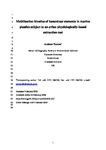Mobilisation kinetics of hazardous elements in marine plastics subject to an avian physiologically-based extraction test.
| dc.contributor.author | Turner, Andrew | |
| dc.date.accessioned | 2018-03-27T12:04:24Z | |
| dc.date.issued | 2018-05 | |
| dc.identifier.issn | 0269-7491 | |
| dc.identifier.issn | 1873-6424 | |
| dc.identifier.uri | http://hdl.handle.net/10026.1/11184 | |
| dc.description.abstract |
Samples of plastic collected from two beaches in southwest England (n = 185) have been analysed by XRF spectrometry for elements that are hazardous or restricted in synthetic polymers (namely, As, Ba, Br, Cd, Cr, Hg, Pb, Sb and Se). Overall, one or more restricted element was detected in 151 samples, with 15 cases exhibiting non-compliance with respect to the Restriction of Hazardous Substances (RoHS) Directive. Twelve plastics that were RoHS-non-compliant were subsequently processed into microplastic-sized fragments and subjected to an avian physiologically-based extraction test (PBET) that simulates the chemical conditions in the gizzard-proventriculus of the northern fulmar. Kinetic profiles of metal and metalloid mobilisation in the PBET were fitted using a pseudo-first-order diffusion model with rate constants ranging from ∼0.02 to 0.5 h-1, while profiles for Br were better fitted with a parabolic diffusion model and rate constants of 7.4-9.5 (μg L-1)-1h-1/2. Bioaccessibilities, based on maximum or equilibrium concentrations mobilised relative to total (XRF) concentrations, ranged from <1% for Cd and Se in polyethylene and polypropylene to over 10% for Br in a sample of expanded polystyrene and Pb in a sample of PVC. Calculations suggest that ingested plastic could contribute about 6% and 30% of a seabird's exposure to and accumulation of Pb and brominated compounds, respectively. | |
| dc.format.extent | 1020-1026 | |
| dc.format.medium | Print-Electronic | |
| dc.language | en | |
| dc.language.iso | en | |
| dc.publisher | Elsevier BV | |
| dc.subject | Avian bioaccessibility | |
| dc.subject | Brominated flame retardants | |
| dc.subject | Heavy metals | |
| dc.subject | Microplastics | |
| dc.subject | Mobilisation kinetics | |
| dc.title | Mobilisation kinetics of hazardous elements in marine plastics subject to an avian physiologically-based extraction test. | |
| dc.type | journal-article | |
| dc.type | Journal Article | |
| plymouth.author-url | https://www.ncbi.nlm.nih.gov/pubmed/29455916 | |
| plymouth.volume | 236 | |
| plymouth.publication-status | Published | |
| plymouth.journal | Environ Pollut | |
| dc.identifier.doi | 10.1016/j.envpol.2018.01.023 | |
| plymouth.organisational-group | /Plymouth | |
| plymouth.organisational-group | /Plymouth/Faculty of Science and Engineering | |
| plymouth.organisational-group | /Plymouth/Faculty of Science and Engineering/School of Geography, Earth and Environmental Sciences | |
| plymouth.organisational-group | /Plymouth/REF 2021 Researchers by UoA | |
| plymouth.organisational-group | /Plymouth/REF 2021 Researchers by UoA/UoA07 Earth Systems and Environmental Sciences | |
| plymouth.organisational-group | /Plymouth/Research Groups | |
| plymouth.organisational-group | /Plymouth/Research Groups/BEACh | |
| plymouth.organisational-group | /Plymouth/Research Groups/Marine Institute | |
| plymouth.organisational-group | /Plymouth/Users by role | |
| plymouth.organisational-group | /Plymouth/Users by role/Academics | |
| dc.publisher.place | England | |
| dcterms.dateAccepted | 2018-01-09 | |
| dc.rights.embargodate | 2019-2-16 | |
| dc.identifier.eissn | 1873-6424 | |
| dc.rights.embargoperiod | 12 months | |
| rioxxterms.versionofrecord | 10.1016/j.envpol.2018.01.023 | |
| rioxxterms.licenseref.uri | http://www.rioxx.net/licenses/under-embargo-all-rights-reserved | |
| rioxxterms.licenseref.startdate | 2018-05 | |
| rioxxterms.type | Journal Article/Review |


